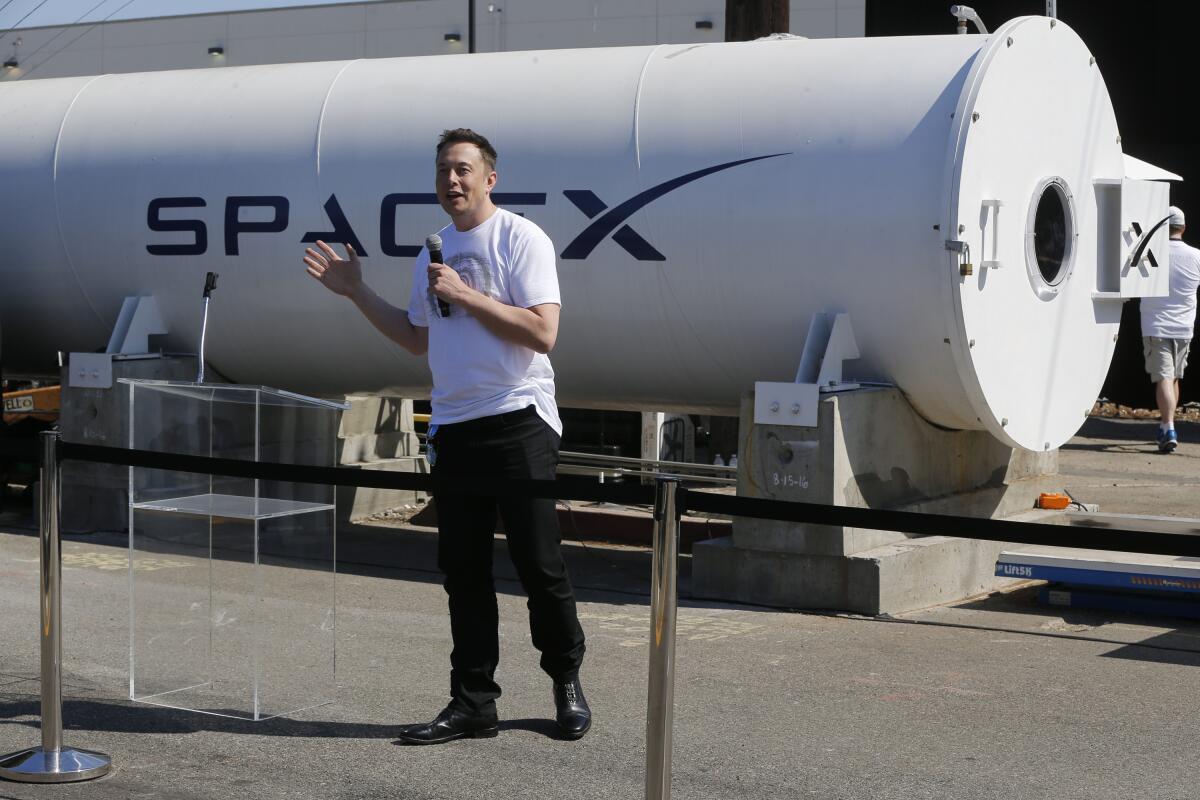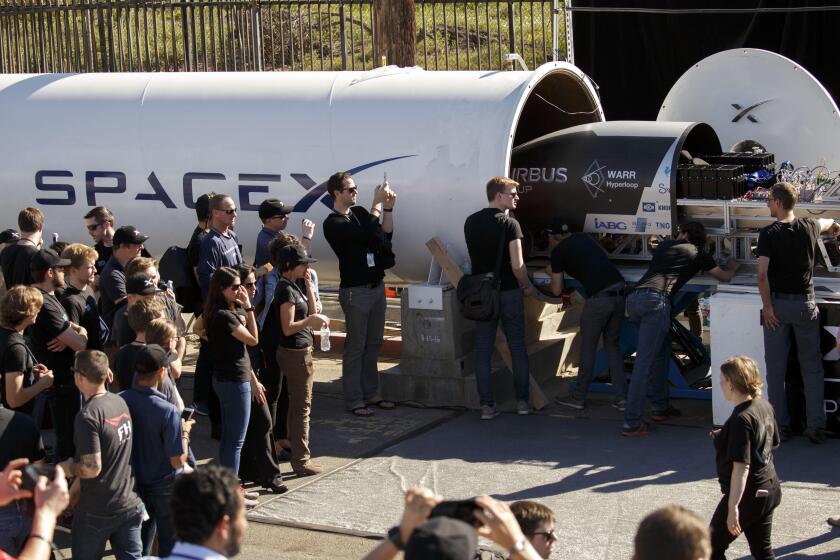Startups’ Hyperloop dreams still distant, almost 10 years after Elon Musk paper

Elon Musk described a dazzling vision: a transit system that could hurl passengers between cities at nearly the speed of sound. His paper on the topic spurred a cohort of big-thinking entrepreneurs to try to create the futuristic transportation system that he called the hyperloop.
But 10 years and hundreds of millions of dollars later, more than a half-dozen startups have tried to create the 760-mph superhighway and none has succeeded. Last year, the Richard Branson-backed startup Hyperloop One cut half its staff and pivoted to moving freight. Outside Musk’s own Space Exploration Technologies Corp., workers put in a parking lot where a hyperloop test tunnel used to be. And earlier this month, one of the longest-standing leaders in the arena, Hyperloop Transportation Technologies, abandoned an attempt to go public.
Hyperloop Transportation Technologies, which goes by HyperloopTT, had planned to list on the New York Stock Exchange via a merger with a special purpose acquisition company, or SPAC, backed by basketball legend Shaquille O’Neal. The deal would have valued the startup at $600 million and provided it with tens of millions in capital. Instead, HyperloopTT is retrenching — an example of the challenges now facing technology companies of all kinds, especially those without much revenue. The failed deal also raises fresh questions about the real-world viability of the idealistic dream of a hyperloop system.
“Building a new form of transportation is severely challenging,” said Rob Miller, chief marketing officer of HyperloopTT. “However, considering the congestion, pollution and discomfort in transportation today, it’s absolutely needed.”
One dogged proponent of the technology is Craig Hodgetts, a now-retired professor of architecture at UCLA. Hodgetts worked with HyperloopTT in 2014 and 2015, enlisting a cadre of graduate students to help design details such as station layouts for the startup. Today, he acknowledges that hyperloop implementation has been hard.
“I was a true believer,” Hodgetts said. “We spent a lot of time convincing ourselves that all the parameters of the project were within grasp, that it was not a fantasy.”
The above-ground Hyperloop testing tube in Hawthorne had sat idle for several years, drawing complaints about road and pedestrian access, as well as questions of its purpose.
Founded in 2013, HyperloopTT is a scrappy startup that for years bootstrapped its efforts, relying heavily on a network of engineers who worked for options and warrants rather than salaries. It announced its SPAC deal in November, intending to merge with a company called Forest Road Acquisition Corp. II — run by former Walt Disney executives Kevin Mayer and Tom Staggs, and backed by O’Neal and others. But the market turned increasingly sour as Forest Road II approached its March 12 deadline to complete a deal, and the companies called it off early this month.
“We wish the HyperloopTT team only the best,” a representative for Forest Road wrote in an email at the time. Last week, it filed to extend its deadline and plans to look for a new target company.
Now, HyperloopTT, headquartered in Los Angeles and Toulouse, France, has lost out on new funding and is facing waning public interest in Musk’s original vision. At the same time, with limited resources, it’s trying to get the green light on several hyperloop projects scattered around the globe.
“Our goal is to aggressively move forward towards commercialization,” Miller wrote in an email days after the SPAC cancellation. “We’ll be announcing more on the projects” in coming weeks and months.
It’s a difficult time to be an experimental company with projects that require hundreds of millions of dollars to build. Last quarter, funding dollars to transportation startups fell by half compared with two years earlier, to $500 million, according to PitchBook data. That’s a much greater drop than software deals, which saw a one-third decline to $12.4 billion in the same period. “I can tell you unequivocally: Software is much easier,” said Lisa Lambert, founder and president of venture firm National Grid Partners.
HyperloopTT will now have to do business the old-fashioned way: winning over paying customers. That means cultivating officials, applying for contracts and making a case-by-case argument for its transportation system, which it aims to license to builders and operators rather than build itself. But tangible progress has been scant, with almost every project the company has announced over the years interrupted or abandoned. That includes an initiative in South Korea in 2017 (a 200-mile route linking Seoul to a southern port), one in China in 2018 (building a track in Tongren, in the mountainous province of Guizhou) and another in Abu Dhabi in 2018 (a proposed 6.2-mile track near Dubai).
Hyperloop Technologies Inc. is seeking at least $250 million in damages from four former high-ranking employees who the company says tried to incite rebellion within the Los Angeles start-up.
“In the natural course of business, some projects advance and others stall,” Miller said. He said the company is continuing conversations in Korea, and is exploring ways to finance a testing and certification facility in Colorado. There’s also some hope in Italy, where HyperloopTT is waiting to hear if it won a bid on a contract. Miller said that a study the company completed in Abu Dhabi led to additional opportunities, including a potential project in the Great Lakes.
That Great Lakes initiative, which HyperloopTT has been officially pitching since 2018, would cover 343 miles from Chicago to Cleveland, plus 134 miles from Cleveland to Pittsburgh. The company said it hoped to begin environmental review later this year. But progress is still a long way off. “It’s three to five years to even imagine a shovel in the ground, and that’s optimistic,” said Grace Gallucci, executive director of the Northeast Ohio Areawide Coordinating Agency.
With the exception of the potential Great Lakes line, almost all of HyperloopTT’s current discussions lack the ambition of its early days. Back then, founder Dirk Ahlborn spoke about city-to-city projects stretching hundreds of miles, using tunnels under vacuum conditions to reduce friction. Projects now are smaller and hard to come by.
HyperloopTT is far from the only company that has struggled with the technology. The original partial-vacuum transportation company, Swissmetro SA, predated Musk when it was founded in 1992. It went into liquidation in 2009, though it has since been reborn as Swissmetro NG. More recently, a Los Angeles-based hyperloop startup called Arrivo shut down in 2018 less than two years after its founding. And Hyperloop One raised more than $400 million before finally giving up passenger travel.
Even Musk’s Boring Co. has run into challenges. When the billionaire first laid out his ideas for the technology, he used the roughly 350-mile route of Los Angeles to San Francisco as an example. Boring’s most substantial project to date is a 1.7-mile tunnel under a convention center in Las Vegas.
Boring has resisted the idea that it’s not on track to build a true hyperloop. In November, the company tweeted a picture of a Tesla in a test tunnel in its Bastrop, Texas, facility, with the message “Full-scale Hyperloop Testing has begun.” But the image puzzled some experts. “Why would you put a Tesla in a tunnel under vacuum?” Douglas Hart, a professor of mechanical engineering at MIT, wrote in an email. “People couldn’t ride in it or they’d be suffocated.”
HyperloopTT has a testing site of its own, near Toulouse, France, where it built a 0.2-mile test track but never installed a planned vacuum system or built a longer track. Late last year, the mayor of Cugnaux, the suburb that houses the facility, complained to a local newspaper Actu Toulouse that HyperloopTT had all but abandoned the site and he hadn’t seen anyone there in months. “The pipe is still there, but there’s no one from Hyperloop in all the meetings we organize,” he told Actu Toulouse.
Miller said the company’s “full-scale prototype resulted from the site, where testing continues, a point of pride.” A spokeswoman for the neighboring city of Toulouse said the company planned to leave the site by the end of the summer, although Miller said it wasn’t yet decided.
Despite its setbacks, it’s still too early to dismiss HyperloopTT and other companies like it, said Erik Wright, founder of commercial construction firm Precision Construction Services, and who has interacted with the company in the past. “I’m really impressed by how far they’ve come and stuck with it,” Wright said. The “hyperloop has lost some of its grandeur,” he acknowledged. “It’s a long game.”
Writer Benoit Berthelot of Bloomberg contributed to this report.







